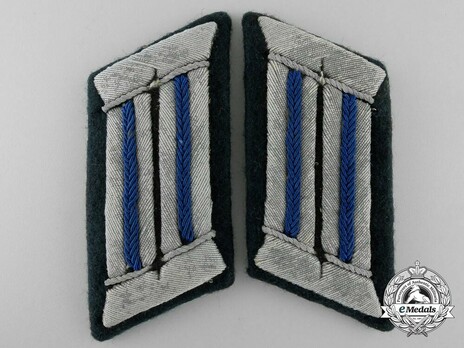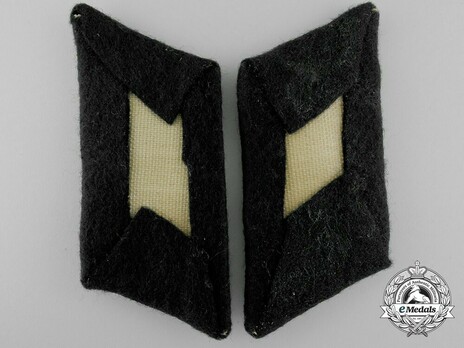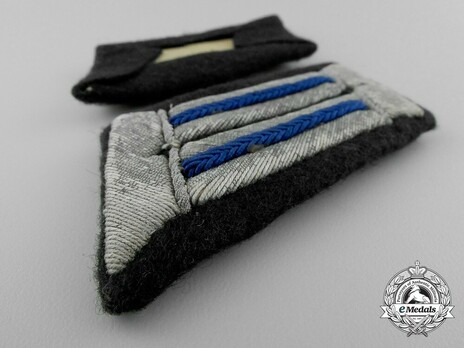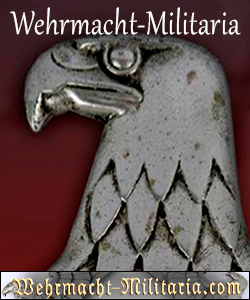German Army Medical Officer Ranks Field Collar Tabs
CATEGORY: Version
SKU: 20.GOR.03.02.03.01.02.02.010.000
Estimated market value:



Estimated market value:
Wool base with gray insignia an dark blue strip in the center. Very Fine.
Two collar tabs or patches were worn by all soldiers on their uniforms in matching, mirrored pairs.
While General ranks wore the same type on all uniforms, lower ranks used regular tabs for their regular uniforms and ones of superior quality for the dress tunic.
Ranks below General ranks show two so-called “Litzen”, which translates to cord, braid, or lace, on their tabs.
The dress tunic tab is branch coloured with silver wire embroidery. The service tunic tab however is more basic, made of dark blue-green material, and uses dull aluminum thread or grey cotton yarn. Some of these tabs have a branch colour as part of the embroidery though.
The dark green tabs of Administrative personnel have three sides edged in the wearer’s secondary branch colour.
Collar tabs can differ significantly in background colour, design, and quality due to production processes.
General ranks normally wore bright red tabs, but other colours were possible for specialist career Generals. There is a gold-coloured embroidery in an Arabesque design on them, the so called “Larisch” embroidery.
A special Generalfeldmarschall pattern was introduced on April 3, 1941. Before they had worn the same pattern as the other General ranks, but now they used a pattern with three middle pieces instead of just two.
Company and Field Grade Officers wore dark blue-green tabs with embroidered double “Litzen”, with the center stripes in the wearer’s branch colour.
In contrast to the ones worn by Enlisted Men and NCOs these “Litzen” have a separated, more pronounced “chapel”, which is the part shaped like a base of a column at each end of a “Litze”. These are also the reason why this type of “Litze” is known as “Kapellenlitze” (chapel Litze).
NCOs and Enlisted Men wore double “Litzen” with branch coloured centre stripes.
However, the version for the dress tunic is a little more elaborate and overall of higher quality. It has silver-coloured “Litzen” on a branch colour tab.
Originally the Litzen were field-grey with a dark grey space between them on a field-grey tab. On September 10, 1935 the dark blue-green tab was introduced.
An effort to standardise collar tabs further was made on November 26, 1938 with the introduction of the “Einheitslitze” (standard Litze). It has a space between the “Litzen”, and the centre stripes are in dark blue-green and no longer in branch colour.
On May 9, 1940 a second pattern was introduced. It has a space between the “Litzen”, and the centre stripes are in mouse-grey. This version was sometimes sewn onto the uniform directly, without the backing in dark blue-green.
In contrast to Enlisted Men, NCOs have special braiding in the form of fine criss-crossing lines on the collar of the uniform.
Tropical uniforms were completed with tabs showing blue-grey “Litzen” with brown centre stripes and middle space between them. These were sewn directly onto the uniform without a backing tab.
Panzer units wore black tabs featuring a metal death’s head insignia. They were completed by branch colour piping. Most wore pink piping, but Panzer artillery units wore bright red, reconnaissance units wore bright yellow piping, signals units wore lemon yellow piping, and panzer engineers wore alternating black and white piping.
Officers starting from the rank of Captain and upwards in the Reichswehr Ministry (RWM), the War Ministry (RKM), the Armed Forces High Command (OKW), and the Army High Command (OKH) wore carmine (with the dress tunic) or dark blue-green (with all other garments) collar tabs embroidered with two gold-coloured “Litzen” with 15 “teeth” on each of the edges.
Officers of the General Staff wore carmine collar tabs embroidered with two silver-coloured Litzen with 15 “teeth”.
These special serrated Litzen were known as Kolbenlitzen.
Branch colours on German Heer headgear was as follows:
Black was worn by Engineer units.
Black/White was worn by Panzer Engineers.
Copper Brown was worn by Motorcycle personnel.
Light Brown was worn by Signals units until 1936, and by Construction troops.
Carmine was worn by the Führer Staff, General Staff Officers, Staff Officers of the Supreme Command of the Army, and all Veterinary branches.
Bordeaux Red was worn by Smoke & Chemical personnel.
Wine Red was worn by Judicial officials.
Bright Red was worn by Generals, Artillery units, and Ordnance Officers (until 1944).
Rose or Pink was worn by all Armored units (including Panzer troops, and Schützen Brigade Staff).
Orange was worn by Recruiting personnel, Ordnance troops, Ordnance Officers (since 1944), and Field Gendarmerie units.
Bright yellow was worn by Cavalry units, and Light Division Staff.
Lemon yellow was worn by Signal units.
White was worn by Infantry units.
Light Grey was worn by Propaganda personnel.
Grey-Blue was worn by Sonderführer (Specialist Officers).
Violet was worn by Chaplains and Field Bishops.
Cornflower Blue was worn by Medical units, and Supply units.
Bright Blue was worn by Transport troops.
Bright Green was worn by Jäger and Mountain units.
Grass Green was worn by Panzer Grenadier units (Armored Infantry).
Dark Green was worn by Administrative personnel.
This list gives a broad and somewhat simplified overview, since the branch colour system got more and more complex between 1936 and 1943. Also, different shades were produced due to varying dye lots and production processes.

Comments
Sign in to comment and reply.


Scroll Top